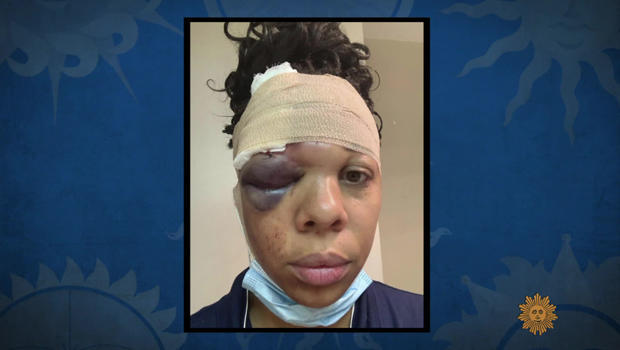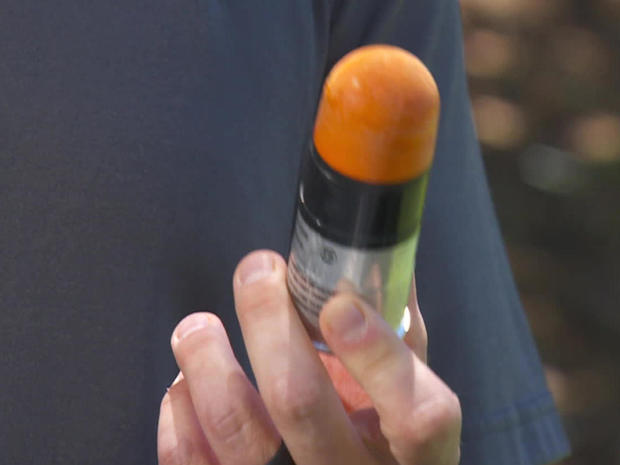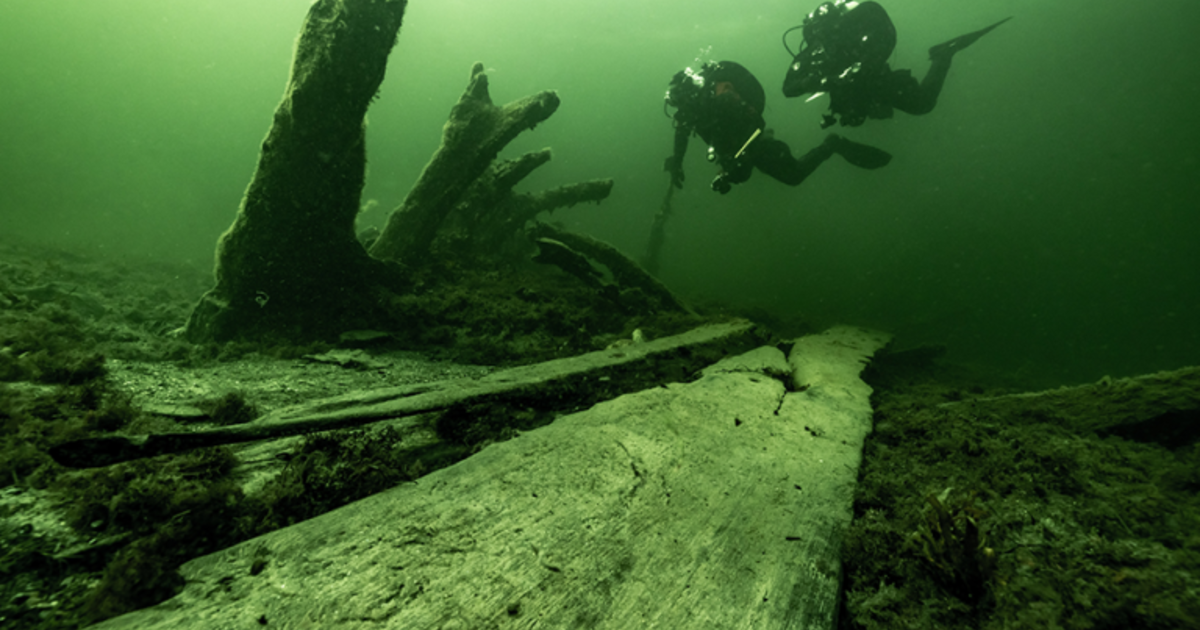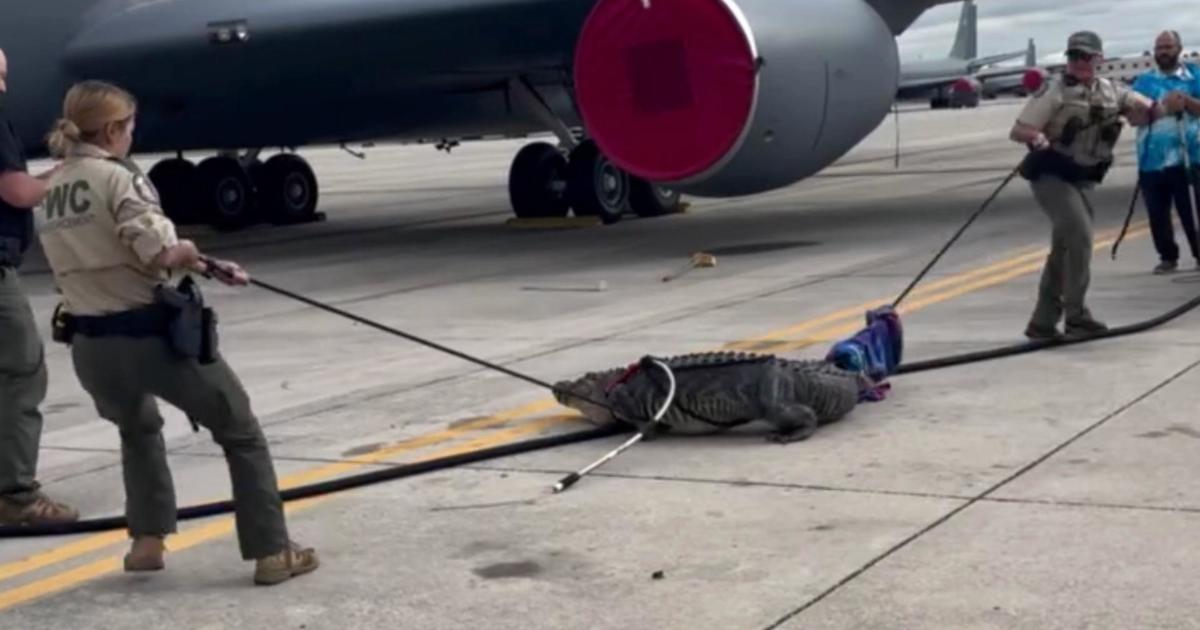The use of "less-lethal" force by law enforcement
The demonstrations in Kenosha, Wisconsin's streets in the name of Jacob Blake started, as most protests do, peacefully. But, as day turned into night, simmering tensions boiled over. Tempers are lost, and so is the message.
For police, balancing the right to assemble with public safety is a delicate one. If and when crowds get out of control, the weapons at their disposal are designed to be less lethal.
But in the weeks of unrest since the death of George Floyd, it's not just violent agitators being targeted by bean bag rounds and foam-tipped projectiles. It's the innocent who are being injured as well.
Take the protest in Fort Lauderdale, Florida, back in May, attended by 34-year-old LaToya Ratlieff was there. "It was very peaceful," she told correspondent Lee Cowan. "There's weren't any issues for the most part of the day."
But something changed. She wasn't sure at the time just what, but clearly the mood had shifted.
"We were kneeling on the ground a good distance away from the officers," Ratlieff recalled. "And even as we were kneeling and chanting and being peaceful, at that time we started to get tear-gassed."
The crowd dispersed, including Ratlieff (she's seen wearing a pink backpack). Then, she was shot in the head by a 40 mm. foam-tipped round – fired, her attorney said, by a Fort Lauderdale police officer. The impact fractured Ratlieff's skull.
She needed 20 stitches.
"I remember people screaming and saying, 'Help, she's been hit. Call 911,'" Ratlieff said. "In my mind I'm not thinking that I was shot because, why would the officer shoot me if I'm not posing any type of threat to him and I'm actually leaving [the scene]?"
Hers is not a unique or isolated incident.
Linda Tirado is a freelance journalist sent to cover the George Floyd protests in Minneapolis. "I didn't realize how big of a deal it was until I had, like, surgeons around me," she said.
Tirado is a veteran of this kind of reporting; she was in Ferguson, Mo., back in 2014 after another police killing, of Michael Brown.
"There's a space where the protesters are gathered in a group and police are gathered in their line," Tirado said. "And the people who are in-between in that space are gonna be media. That's how you get that understanding of what's going on, is you stand and you watch both sides."
That's what she was doing in Minneapolis in May; this is the last photo she took that night, which appears to show an officer aiming a less-lethal weapon directly at her:
"I think that not shooting people in the face for exercising the first thing we fixed about the Constitution should just be standard operating procedure," Tirado said.
The non-lethal round shot at Tirado that night blinded her in her left eye.
"I can see to about here – and everything past, everything from here to here, is just blank," she said. "I'm assured that as I become used to having one eye, I'll be able to do all the things I used to do without it being a problem. But the getting used to having only one eye is not a small task."
To be sure, police have been injured in the protests, too. Hundreds of them – more than 50 on one particularly violent night in Seattle recently. Crowds can be dangerous; dispersing them is often necessary. But the research on the lethality of "less-lethal" weapons is pretty hard to come by.
In 2017 a review of the available literature on the subject was published in the medical journal BMJ Open. Of the nearly 2,000 people since 1990 documented to have been injured by "less-lethal" rounds, 300 suffered permanent disability; 53 of them died.
"These are large, dense, high-speed projectiles, and they cause significant and severe injuries," said Dr. Rohini Haar, who is with Physicians for Human Rights, and is one of the authors of that review. "The basic rights, like free speech and free assembly, are being suppressed globally, and the primary way that that's happening is because of crowd-control weapons."
In just the first week after the death of George Floyd, Dr. Haar documented at least 100 serious injuries to protesters and journalists, most to the head and neck.
"The narrative is that they're not lethal, they're not dangerous, that police need a continuum of use of force, and that these are really excellent options for them to be safe while, at the same time, controlling riots," Dr. Haar. And that, she said, "is absolutely not the case."
While most police departments have access to less-lethal weapons, experts say few are offered any significant training in how to use them.
"I've talked to agencies, we've never seen crowd control, we didn't even know what to do," said Travis Norton, an instructor with the California Association of Tactical Officers. He specializes in less-lethal weapons – not only how to use them, but when.
Cowan asked, "How do you deal with a group of agitators in the middle of peaceful protesters?"
"There are a lot of different tactics you can use," Norton said. "Unfortunately, a lot of those departments don't know what those tactics are.
"What are we trying to accomplish with what we're trying to do? Are we just standing here on a skirmish line and deploying impact munitions at protesters hoping he'll go away, or do we have an actual strategy here?" he said.
Rules of engagement have to be set, he said, because the risk of injuries is almost inevitable. Unlike live ammunition, less-lethal projectiles are unpredictable. Where an officer aims and where the munitions hit can be two different things.
Norton said, "Law enforcement is screaming for something better for us to use than what's out there. In the last 20 years, we have had no new less-lethal come out, other than prototypes and pilot projects."
Until something better comes along, Norton said, less-lethals will likely remain a crowd control option for police departments.
What doesn't have to remain, he said, is the cloud around their use: "A lot of times what happens within law enforcement is, these things happen, and then we just forget about them because we're on to the next emergency. And it's not purposeful, it's just we don't have a lot of time to reflect on things, and we have to do better at that."
Despite her injuries, LaToya Ratlieff has kept demonstrating; peaceful protest is in her DNA … literally. Fannie Lou Hamer, a hugely influential civil rights leader in the 1960s, is her great-aunt. She, too, was bloodied in her battles.
Less-lethal munitions were meant to be a step forward from those dark days, but like the fight for civil rights itself, that work is not over.
Ratlieff told Cowan, "It was always taught to me early on that if you want to see change, if you want to see good in your community, that you have to be a part of it. I do think it's important to continue to participate, because there's still so much change that needs to happen."
For more info:
- Follow Linda Tirado on Twitter
- Dr. Rohini Haar
- Physicians for Human Rights
- California Association of Tactical Officers
Story produced by John Goodwin. Editor: Ben McCormick.






